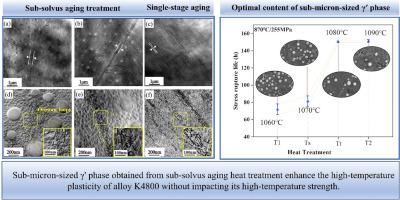Journal of Materials Science & Technology ( IF 11.2 ) Pub Date : 2024-06-29 , DOI: 10.1016/j.jmst.2024.06.014 Peng-Fei Zhao , Kun-Lei Hou , Min Wang , Mei-Qiong Ou , Ya-qian Yang , Ying-Che Ma

|
For nickel-based superalloys with medium volume-fraction γʹ phase (20 %–40 %), dual or multi-stage aging treatments are usually conducted to generate a microstructure containing the multimodal distribution of γʹ for a balance of strength and plasticity. In the present study, the microstructure and high-temperature properties of a novel cast nickel-based superalloy K4800 were investigated after being subjected to three heat treatments (HT) procedures, namely HT1: 1180 °C/4 h + 1090 °C/2 h + 800 °C/16 h, HT2: 1180 °C/4 h + 1060 °C/2 h + 800 °C/16 h and HT3: 1180 °C/4 h + 800 °C/16 h. It was found that the sub-solvus aging treatments at 1090 and 1060 °C precipitated sub-micron-sized (∼300 nm) primary γʹ phase which enhanced the ductility during 800 °C tensile (the total elongation of T1, T2, and T3 samples were 6.75 %, 7.3 %, and 3.25 %, respectively) without evidently impairing the strength. After careful microstructure observation and deformation mechanism analysis, the enhancement of elongation was rationalized that the precipitation of the sub-micron-sized primary γʹ phase decreased the volume-fraction and size of the nanometer-sized γʹ phase which was precipitated at 800 °C, and simultaneously, promoted the dislocation movement by suppressing the non-planar slip. However, an excessive amount of the sub-micron-sized primary γʹ phase led to a faster ripening process of the nanometer-sized γʹ during creep, which decreased the creep life at 800 °C/430 MPa (T1: 125 h, T2: 199 h, and T3: 198 h). Based on this, we monitored the number density of nanometer-sized γʹ phase coexisting with different amounts of large γʹ during creep. An area fraction less than 7 % of the sub-micron-sized γʹ phase was considered to have little detrimental effect on the creep life of K4800 alloy, which corresponded to a sub-solvus temperature range about 1080–1090 °C.
中文翻译:

低于固溶线时效对新型铸造镍基高温合金拉伸和蠕变性能的影响
对于中等体积分数γʹ相(20%~40%)的镍基高温合金,通常进行两级或多级时效处理,以产生含有γʹ多峰分布的显微组织,以实现强度和塑性的平衡。在本研究中,研究了新型铸造镍基高温合金 K4800 经过三种热处理(HT)程序(即 HT1:1180 °C/4 h + 1090 °C/2)后的显微组织和高温性能。 h + 800 °C/16 h,HT2:1180 °C/4 h + 1060 °C/2 h + 800 °C/16 h 和 HT3:1180 °C/4 h + 800 °C/16 h。研究发现,1090 和 1060 °C 的亚固溶线时效处理会析出亚微米尺寸(~300 nm)的初生 γʹ 相,从而增强了 800 °C 拉伸期间的延展性(T1、T2 和 T3 的总伸长率)。样品的含量分别为 6.75%、7.3% 和 3.25%),但强度没有明显降低。经过仔细的微观组织观察和变形机制分析,伸长率的提高合理化为亚微米级初生γ′相的析出降低了800℃时析出的纳米级γ′相的体积分数和尺寸,同时,通过抑制非平面滑移来促进位错运动。然而,过量的亚微米级初生γʹ相导致蠕变过程中纳米级γʹ的成熟过程加快,从而降低了800 ℃/430 MPa下的蠕变寿命(T1:125 h,T2: 199 小时,T3:198 小时)。在此基础上,我们监测了蠕变过程中与不同数量的大γ′共存的纳米级γ′相的数密度。 亚微米尺寸γ′相的面积分数小于7%被认为对K4800合金的蠕变寿命几乎没有不利影响,其对应于约1080-1090°C的亚固溶线温度范围。
















































 京公网安备 11010802027423号
京公网安备 11010802027423号